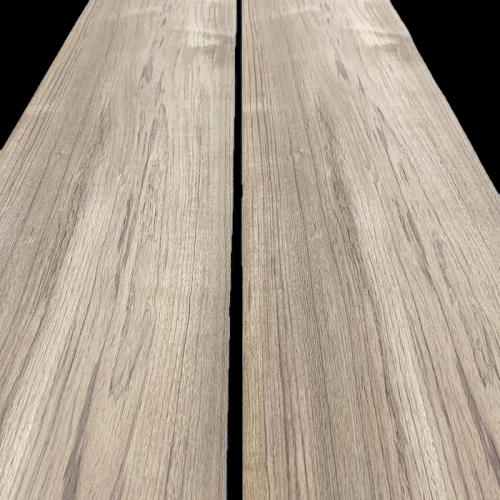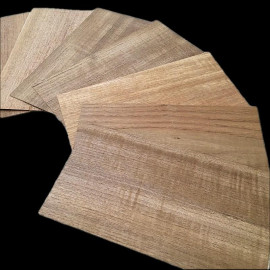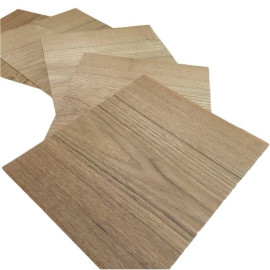
Teak Crown-cut Veneers 280 x 36 cm
Teak Crown-cut Veneers 280 x 36 cm
Genuine wood sliced-veneer sheets, in sequence.
Length: 280 cm.
Width: 36 cm.
Thickness: 0.5 mm.
Sold by the sheet.
Warning! Read carefully the description.
These photos are taken from the veneer sheets you will receive.
Teak Crown-cut Veneers 280 x 36 cm
Genuine wood sliced-veneer sheets, in sequence.
Warning! This veneer has an open pin-knot in the middle of the width, at 120 cm of the top end, as shown in one of the pictures.
Dimensions:
Length: 280 cm.
Width: 36 cm.
Thickness: 0.5 mm.
Measurement scaling:
The width is rounded to the covered centimeter. For example, 15.8 cm is given 15 cm.
The length is rounded to 5 centimeters. For example, 257 cm is given 255 cm.
Pictures:
These photos are taken from the veneer sheets you will receive.
While we strive to capture the color as accurately as possible, please note that the color may vary slightly from the photo. The screen on which the photos are viewed can also affect their appearance.
What is Teak wood?
What are the common names of Teak?
Teak, Teca, Teck, Kyun, May sak, Tek.
What is the botanical name of Teak?
Tectona Grandis.
What is the origin of Teak wood?
Although called Indochina Teak, this wood is endemic to India, Laos, Malaysia, and Thailand and is nowadays found as plantation wood in all tropical and subtropical areas.
Since antiquity (Teak beams were found as a structural element along the Roman road in India), Europe experienced its first success in building sailboats at the end of the 17th century.
Nowadays, Teak is still the wood of choice for shipbuilding yachts and luxury sailboats, whether for decks or other exterior elements such as the railing.
How do you recognize Teak?
Teak is an oily wood species and should be degreased with acetone to allow a strong gluing and a good finish.
Teak has a hollow structure reminiscent of Oak but no dominant flake.
Its color ranges from golden honey, for the lighter ones, to caramel brown.
This wood is characterized by elegant black veining; however, occasionally, a piece is without veining and of a light color; we will then speak of blond Teak, a rarity in veneers.
Indeed, to allow smooth slicing, teak logs are cooked to soften the wood fiber, which creates these black veins. As teak timbers are sawn raw, lumber is less prone to veining.
What are the mechanical properties of Teak?
Weight: 650 Kg/m3, average at 10-12% humidity.
Janka hardness: 4740 Newton; for comparison, Oak is 4980 N, and Poplar is 1650 N.
Elasticity: 12.28 Gigapascals; for comparison, Ash is 12.31 GPa, and Poplar is 9.75 GPa.
Crushing strength: 54 Megapascals; for comparison, Hard maple is 109 MPa, and Oak is 47.3 MPa.
It is a wood with good outdoor resistance. However, since the veneer is thin wood, using it for outdoor applications would be risky unless encased in an epoxy shell, such as surfboards.
What are the uses of Teak?
Since antiquity (Teak beams were found as a structural element along the Roman road in India), Europe experienced its first success in building sailboats at the end of the 17th century.
Nowadays, Teak is still the wood of choice for shipbuilding yachts and luxury sailboats, whether for decks or other exterior elements such as the railing.
Until a few years ago, Teak was considered a semi-precious wood, but with soaring demand, its price has reached that of precious woods.
What are Wood Veneers?
Veneers are thin sheets of wood obtained by slicing or peeling.
Their surface has the appearance of planed wood without any finish or treatment. They are neither glued nor backed with any other material. This means that both faces of the sheets can be used.
Wood Veneers are mainly used to cover less aesthetic substrates such as plywood or particleboard to make furniture or wall panels.
Veneers are also used to create decorative objects such as lamps, jewelry, bookmarks, and more.
By assembling several sheets of veneer on top of each other, it is possible to manufacture objects requiring high mechanical resistance, such as skis, bicycle frames, or musical instruments.
The applications of veneer are as varied as they are multiple.
Since veneers are genuine wood, all wood finishing products, whether varnish, stain, or oil, are suitable. The choice of finish will depend on your personal preferences and the final use of the object.
The veneer offered here is a sliced sheet of uniform thickness, but the thickness might differ from one species to another. The standard thickness is around 0.6 mm.
Although the edges of the veneers have been cut roughly straight, the cut is not perfectly parallel. Some veneers may retain the natural taper of the tree, being slightly wider at the foot than at the top.
Some veneers may have a trace of a waney edge (an edge following the tree's natural shape) on the sides. In this case, the dimensions indicated correspond to the minimum width of the veneer, as specified in the "Dimensions" paragraph.
How to use veneers?
How to cut the veneers?
Veneers can be easily cut with a utility knife.
For straight cuts, the best results are obtained with a veneer saw.
Use a fretsaw, scalpel, or veneer knife for curved cuts.
Always allow for a slightly larger veneer sheet than your intended surface. This will allow you to adjust the size after gluing for a clean finish.
A flush trimmer can also be used to trim the veneer after gluing.
When cutting with a utility knife or veneer knife, it is best to cut with the grain of the wood. To check this, run your finger along the edge of the sheet. The direction that feels smoothest is the ideal direction for cutting.
What is veneer splicing?
As the veneers have the width that nature gave us, you might need to cover an area wider than the veneers available.
Therefore, you need to splice the veneers by gluing or fixing them, side by side, with tape to obtain the desired width.
Trim the veneer's edges with a straight and smooth cut to realize good jointing.
Stick the veneers with tape (the blue one is a good choice.)
Usually, the veneers are spliced side by side, but to obtain a longer length, they can be done foot by foot.
The splicing must be done before gluing the veneers on the substrate.
What Glue to Use for Veneering?
Several types of gluing are possible.
Vinylic glue (PVA or PVB) is well adapted to porous substrates such as plywood, particle board, or MDF. The veneers must be pressed with clamps over the entire surface at once.
Note: A technique using vinylic glue and an iron can also be used to glue veneers, but we strongly recommend choosing this technique only if other gluing solutions are impossible.
- Neoprene glue is applied to all surfaces, especially non-porous surfaces, using two coats of glue and marouflage.
- Animal glue, such as hide, sinew, or bone glue, are pellets that must be cooked in a double boiler and used hot.
How to Sand Veneers?
Veneers and all our products are genuine wood and can be sanded according to thickness.
Please do not use a belt sander, regardless of the thickness of the veneer, as this could pierce it.
With a 0.6 mm veneer, lightly sand with 120 grit and then finish with 180 or 240 grit. With an orbital sander, 180 grit is already sufficient for most applications.
How to Finish a Veneer Realization?
All finishing products generally used for wood are suitable for finishing our products. For example, you can use a varnish, wax, paint, or oil.
However, ensure that the product you want to use is compatible with the final use of your creation.
More information:
Please look at our TUTORIALS; you might find some valuable tips.
Please contact us by email or phone for any additional information.
You might also like
 English
English









